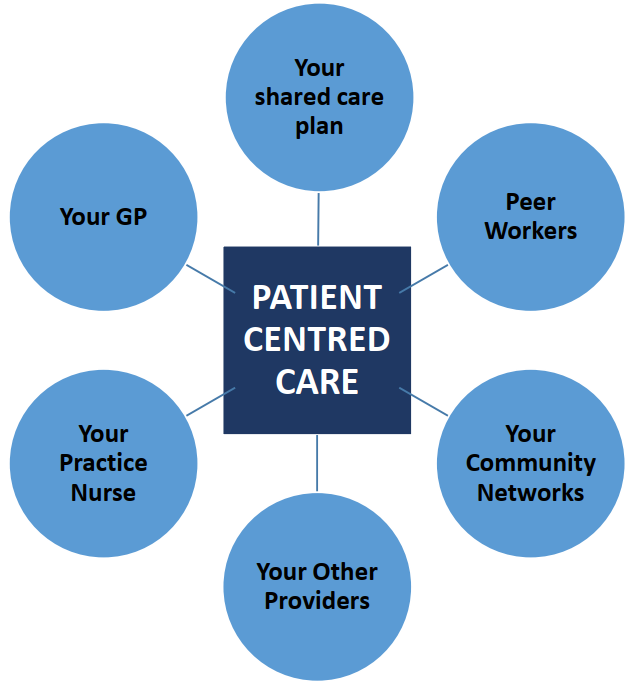Introduction to Management, Monitoring & Communications

Fibromyalgia (FMS) is classified as a primary chronic pain condition (WHO International Classification of Diseases: ICD-11 Version: 2019). Estimates indicate that as many as 1 million Australians (3-5%) experience this chronic pain condition. You are not alone!
Living with any chronic condition can be overwhelming for many people. Illness can impact your physical, mental and emotional health, and greatly affect your everyday life.
The great news is that Fibromyalgia – just like Diabetes and other chronic conditions, can be managed in General Practice using the patient-centred, collaborative, therapeutic, shared care approach.
Patient-Centred Shared Care involves you working together with a range of health care providers to manage your chronic conditions, health and wellbeing. You are at the centre of your health care team and you make the decisions about treatment options and management choices in collaboration with your care team.
Shared Decision Making
What is shared decision making?
Shared decision making is an important aspect of patient-centred health care in Fibromyalgia. It is a process in which you work together with your health providers to make decisions and select tests, treatments and care plans based on clinical evidence that balances risks and expected outcomes with your preferences and values.
Shared decision making enables you to:
- learn about your health and understand all your health conditions, including Fibromyalgia
- ensure that when decisions need to be made, you are informed about all options.
- understand the pros and cons of different options
- have the information and tools you need to evaluate your options
- be better prepared to talk with your health care providers
- work together with your health care team to make decisions that are right for you
- monitor and keep records so you can provide accurate information back to your health care team
Self-Monitoring and Feedback
Self-monitoring is an important step in Fibromyalgia management because symptoms can fluctuate and change over time.
Self-monitoring involves you keeping a record of your symptoms, treatments and life activities. The information you record can be used to:
- identify symptom changes
- link symptom changes to daily activities
- gauge the effectiveness of treatment
- communicate effectively with health providers
There are a range of programs that enable you to improve knowledge and skills, including:
The Best Practice Australian Fibromyalgia Integrated Education Model (2012):
(Contains 8 components or core steps consistent with the Flinders Chronic Disease Management Program):
- Have knowledge of Fibromyalgia and management options
- Have a treatment and care plan to coordinate a healthcare team
- Actively share in decision making with the healthcare team
- Monitor and manage the signs and symptoms of Fibromyalgia
- Manage Fibromyalgia using a mixture of medical and lifestyle decisions (physical, mental, emotional and social life)
- Adopt a lifestyle that promotes health (sleep, stress, diet and movement)
- Access community and other support services
- Regularly review the care in partnership with your case manager
The Annual Fibromyalgia Cycle of Care
What is a Cycle of Care?
A Cycle of Care is a checklist for reviewing the range of interventions in Fibromyalgia management.
It is important to have a regular Cycle of Care as a systematic program to identify any health concerns early and discuss the best treatment options.
The checklist contains core topics from generic chronic disease management programs adapted specifically for people with Fibromyalgia. It provides a useful management tool for you to work with your health care team to demonstrate your Fibromyalgia management is proactively managed and coordinated.
How to support your Proactive (Self) Management
Take charge – become more proactive in your own healthcare management, referrals and care plans.
Knowledge is empowering, it enables you to be more confident in decision making and communicating with your healthcare team.
Learn new skills to:
- improve your knowledge about Fibromyalgia, its signs and symptoms
- keep records to better understand how Fibromyalgia symptoms affect you on a daily basis
- learn about treatments and management options and how you can improve health outcomes
- actively share in decision-making
- use treatment and care plans effectively
- monitor and provide feedback to update your treatment choices
- communicate effectively with healthcare and service providers
- manage the impact on your physical, emotional and social life
- access community and other support services
- advocate for yourself with service providers and government departments
- have the confidence and ability to work with members of your healthcare team
For further information, see
Patient Leaflet 6. Introduction to Fibromyalgia Cycle of Care